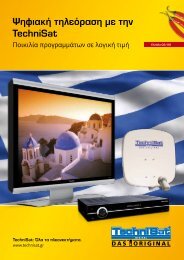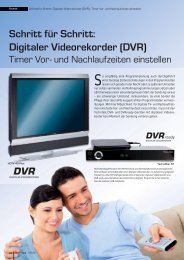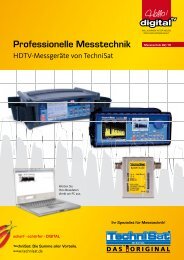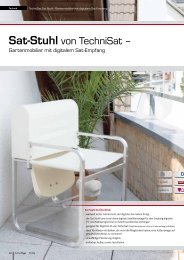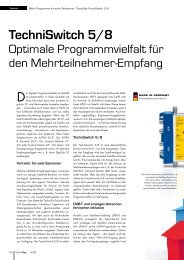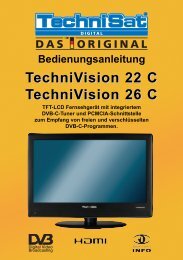Sat in the city:
Sat in the city:
Sat in the city:
Create successful ePaper yourself
Turn your PDF publications into a flip-book with our unique Google optimized e-Paper software.
to make <strong>the</strong> leap<br />
analogue to digital!<br />
Economical switchover to<br />
Digital<strong>Sat</strong><br />
The access to digital satellite broadcast<strong>in</strong>g<br />
is also good value and can<br />
often be problem-free. The modest<br />
one-off purchase costs are directly<br />
comparable to VAT and a clear plus<br />
po<strong>in</strong>t when compared to watch<strong>in</strong>g TV<br />
via satellite: A top quality complete<br />
system, with satellite dishes, a digital<br />
receiver and <strong>the</strong> required cables<br />
is already available for around 180<br />
euros. And this only applies when <strong>the</strong><br />
household does not already have an<br />
old satellite system to hand. In <strong>the</strong><br />
latter case, <strong>the</strong> old parabolic antenna<br />
can usually be reused without any<br />
problems. This means complex new<br />
cabl<strong>in</strong>g systems are also generally not<br />
necessary, which reduces <strong>the</strong> costs required<br />
for <strong>the</strong> switchover to receiv<strong>in</strong>g<br />
Digital<strong>Sat</strong> even fur<strong>the</strong>r as a result.<br />
Expensive cable charges<br />
often unnecessary<br />
In view of <strong>the</strong> cont<strong>in</strong>ually climb<strong>in</strong>g<br />
costs for leasers and house-owners to<br />
view analogue and digital cable, <strong>the</strong><br />
switchover to satellite receiv<strong>in</strong>g is often<br />
of benefit to all parties concerned.<br />
S<strong>in</strong>ce <strong>the</strong> costs of <strong>the</strong> retrofitt<strong>in</strong>g to<br />
digital satellite receiv<strong>in</strong>g equipment<br />
are limited to <strong>the</strong> <strong>in</strong>itial basic outlay,<br />
<strong>the</strong> costs of a satellite system are<br />
balanced out by <strong>the</strong> <strong>in</strong>clusion of <strong>the</strong><br />
yearly cable costs <strong>in</strong>curred, possibly<br />
very swiftly. Moreover, <strong>the</strong> standard<br />
set of programmes provided via cable<br />
rarely exceeds a total of 60, regardless<br />
of whe<strong>the</strong>r it is analogue or digital<br />
broadcasts.<br />
Retrofitt<strong>in</strong>g of exist<strong>in</strong>g<br />
receiv<strong>in</strong>g units<br />
Analogue systems for receiv<strong>in</strong>g satellite<br />
broadcasts can usually be retrofitted<br />
problem-free with <strong>the</strong>ir own<br />
<strong>in</strong>tr<strong>in</strong>sic energy. For anyone who is<br />
unsure whe<strong>the</strong>r <strong>the</strong>ir own satellite<br />
system is suited for digital receiv<strong>in</strong>g<br />
or not, it is worth contact<strong>in</strong>g a specialist<br />
for advice. The retrofitt<strong>in</strong>g only requires<br />
<strong>the</strong> exchange of two parts: First<br />
<strong>the</strong> analogue satellite receiver (also<br />
known as <strong>the</strong> receiver or set-top box)<br />
and also <strong>the</strong> LNB (Low Noise Block<br />
Converter), which, from a technical<br />
perspective, represents <strong>the</strong> actual<br />
receiv<strong>in</strong>g unit for <strong>the</strong> transmission of<br />
radio waves from <strong>the</strong> orbit. We will<br />
cover <strong>the</strong> selection of a suitable satellite<br />
receiver <strong>in</strong> a moment, but what<br />
does <strong>the</strong> mysterious acronym LNB actually<br />
stand for? The LNB represents<br />
<strong>the</strong> receiv<strong>in</strong>g section of <strong>the</strong> parabolic<br />
antenna. It is located <strong>in</strong> front of <strong>the</strong><br />
satellite dish and mounted on a small<br />
extension arm. This is also a piece to<br />
be exchanged, and <strong>the</strong>n to reconnect<br />
<strong>the</strong> cable/s lead<strong>in</strong>g from <strong>the</strong>re<br />
to <strong>the</strong> receiv<strong>in</strong>g unit (receiver). S<strong>in</strong>ce<br />
<strong>the</strong> connection of <strong>the</strong> cable is usually<br />
made via <strong>the</strong> conventional F-plug,<br />
which is also <strong>in</strong>cluded on <strong>the</strong> receiver<br />
itself, <strong>the</strong> procedure can usually be<br />
INFODIGITAL December 2008 35



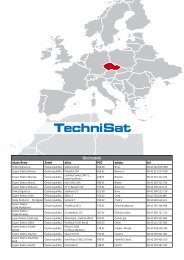

![[PDF] TV numérique avec TechniSat](https://img.yumpu.com/7390326/1/184x260/pdf-tv-numerique-avec-technisat.jpg?quality=85)
